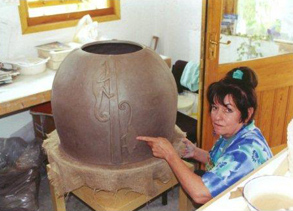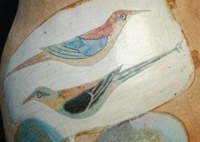- Top
- |
- Ceramics
- |
- Profile
- |
- Information
- |
- Paintings

Personal History
Encouraged by family members, Jill Fanshawe Kato started drawing at an early age.Her interest in the natural world was awakened at the age of ten, when her family moved from Nottingham to the small Devonshire village of Kingskerswell, near Torquay. She cared for numerous injured or orphaned wild birds and animals and had a tame jackdaw which stayed for 3 years before returning to the wild. Thus started her lifelong love of nature which can be seen today in her ceramics.Travel to Spain, Asian countries, Brazil, to mountains and tropical islands such as the Maldives and Okinawa have all acted as sources of inspiration for Jill’s ceramics.
She graduated in Painting from Chelsea School of Art, London, then gained an Art Teacher’s Certificate. After a period of teaching she had the opportunity to visit Tokyo in Japan.
Even in the cheapest restaurants a long fish would be served on a long rectangular blue and white dish, with a variety of small dishes to complement the food. Sushi in shades of crimson, orange, yellow and silver appeared on a simple wooden board, beside it a yunomi cup of tea with fishing net painted on it. Expensive restaurants would use or display pottery by famous ceramic artists and handmade ceramics were a part of everyday life. As a result of these experiences, Jill joined the school of potter Yosei Itaka and began to study Japanese pottery. This study was enhanced by visits to many of the traditional pottery towns and villages, some in production for over 1000 years. She tried Karatsu clay at Musoan Pottery School, near Tokyo, and experimented in the disused studio of a friend, with many kinds of clay and glazes fired in a gas kiln.
Returning to London in 1977, Jill established her first studio with a grant from the Crafts council. Since then, she has lived and worked in north London with her husband, Japanese photo-journalist Setsuo Kato. She continues to exhibit in Japan, with 43 exhibitions there, mainly at Keio Department Store in Tokyo but also in Okinawa. She has exhibited widely internationally and across the UK.Jill was a lecturer on the Postgraduate Ceramics Diploma course at Goldsmiths College, London, for 17 years and tutor at Lambeth Institute and Kingsway College. She lectures widely on ceramics, demonstrates and teaches.
She has worked at the studio of potter Ryoji Koie in Japan and was recently invited to two ceramic residencies in Spain.
Interests include keeping an allotment with her husband, countryside walking, bird-watching, horse riding, going to exhibitions, sketching, travel.
Jill is currently establishing a studio in Devon.
Brief Description of Work
Jill’s ceramics are inspired by the natural world and by travel. Making processes include coiling, slabbing, sculpting, using moulds and throwing and altering. Slips and glazes are applied for colour, which she constantly experiments with. She uses a range of stoneware clays and is currently experimenting with additions of River Dart clay, fired to 1270 degrees c. in a Laser gas kiln. Some raku pottery is also made.
Work ranges from functional pottery for Western and Japanese use to large sculptural commissions and wall murals.
「自然からのインスピレーション!」
ジル・ファンショー加藤の陶芸の世界

ジルさんは子供の頃、デボンシャーの小さな村に住んでいました。小鳥や動物好きが近所で有名になり、怪我をしたり、巣から落ちた鳥たちがジルさんのところへ持ち込まれました。彼女は一生懸命面倒を見ました。ジャックドーと呼ばれる小型のカラスは3年もジルさんと一緒に住みました。海にも良く行きました。泳いだり、美しいデボン海岸を散歩したりして自然と親しみました。
自然とのかかわりはジルさんの陶芸にも良く出ています。それはイギリスの自宅の庭を訪れる小鳥だったり、田園地帯の野ウサギだったり、モルジブの熱帯魚だったり、ブラジルのジャングルだったり、スペインや沖縄の太陽の印象だったり様々です。でも共通しているのは自然からのインスピレーションということです。
チェルシー美術大学で油絵を専攻したジルさんは日本で本格的に陶芸の修行をしました。備前焼を制作している井高洋成さんに師事しました。唐津焼の陶房「無想庵」でも制作しました。日本の陶芸の奥の深さに感動したジルさんはその後も頻繁に日本を訪れ、各地の陶芸の里を訪れ、たくさんの日本人陶芸家と親交を深めています。最近ではよく岐阜県にある鯉江良二さんの窯場でも制作しています。
日本の陶芸の世界を良く知る英国人陶芸家としてジルさんは日本や英国を始め、中国、フランス、アメリカ、ニュージーランド等で展覧会を開催しているだけでなく、日本の陶芸に関する講義、ワークショップ、住み込み芸術家等、多忙な生活を送っています。
‘Over the past three decades Jill’s distinctive stoneware vessels decorated with images drawn from the natural world have been exhibited internationally, but most particularly in Japan and the UK. Fanshawe Kato frequently visits Japan to exhibit and study and her work is suffused with an intelligent understanding of the particular art of Japanese pots which she also in a modest way collects. The tactile, animated qualities- the ‘atatakai’ as the Japanese expression has it- are clearly evident in her work. Yet there is also in the stylised bird, fish and plant forms and indeed the bold, gestural abstract blocks of colours, a quintessentially English quality, a kind of gentle humour that one sees in the works of painters such as Mary Newcombe or the illustrations of Eric Ravilious.
The artist uses the unglazed surface of the vessel- usually a buff ochre colour, sometimes textured- as a counterpoint to the incised or painted imagery. The images both draw the eye as they stand alone in their field of colour, but through their careful placing around the volume of the pot they also serve to emphasise the form. In this way painting and pot become one, fusing as it were the different cultures from which they spring.’
Amanda Game, Director, Scottish Gallery
‘This potter’s many links with Japan are not only evidenced in the many solo exhibitions she has held in that country, but also in the manner in which the ceramic ethos of her training there has influenced her work. Fanshawe Kato frequently looks at a teabowl made by Ryoji Koie which, by virtue of having been removed from the kiln when yellow-hot and allowed to cool, has achieved a lustrous black glaze. The foot of the bowl is so rough and unmanicured that it is like a rugged landscape and is a constant reminder to Jill Fanshawe Kato of the significance of keeping her work close to nature. It is doubtful that she will ever forget this because her generosity in appreciating the work of others also keeps her open to the immense significance of the natural world.’
Ian Wilson, Art Critic